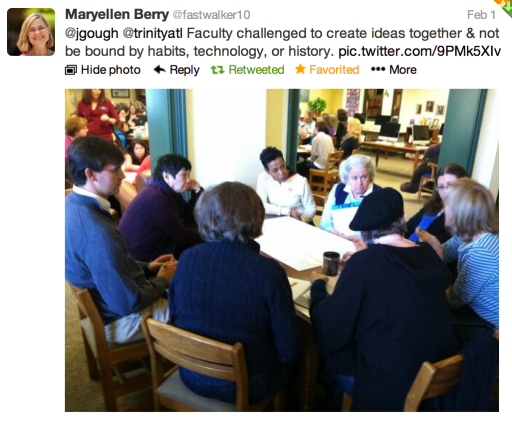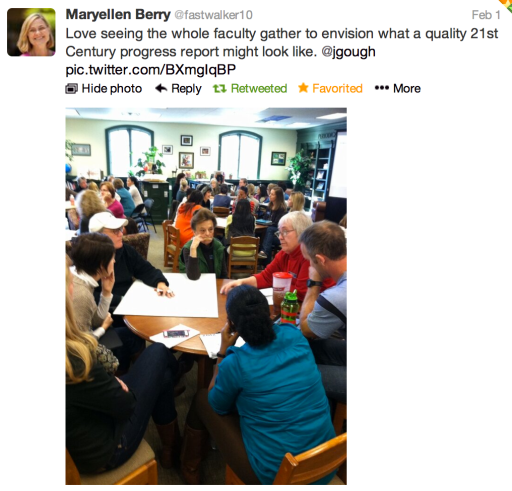PD Lesson Planning: Progress Report Ideation – Part 1 shared the agenda (or lesson plan) for Part 1 of a planned 2-part series on progress reports.
I arrived just in time to prevent the theater seating setup of 150 chairs in the Media Center. M. Burris, one of our Media Specialists, helped me think how to use the existing furniture since we planned to work in small groups. We decided to set up 3 additional tables with 6 chairs at each table. We predicted that everyone would have a seat for the meeting, and we wanted to use our space well.
It was great to have all divisions at this meeting. Normally the Very Early Learning Division (VELD) faculty would meet at 12:30 and the Early Learning Division (ELD) and Upper Learning Division (ULD) would meet at 3:30. (As a side note, we need to think about finding opportunities for all divisions to work together more often.)
As soon as everyone was seated, I launched the quick write using the slide shown below.
The purpose of the quick write was to take the opportunity to organize thoughts and focus on the task at hand. Of the 80+ participants, 8 used the Google form to share their thinking. Remember, we are not making decisions; just thinking aloud with each other.
Here’s some of what they shared:
I love the opportunity to share positive information with parents. I am intentional to provide instructional feedback before the progress report goes home, but this is a great time to give the needed positive and affirming communication to parents.
_______________
They make you think about every child as an individual and make you realize you know more about them than you think.
_______________
[I wish for] A way to more clearly communicate with parents that the progress report is about PROGRESS and not about a finite expression about a child’s trajectory in life!
After the quick write, we shuffled into vertical teams. We asked that each team have at least one Specials teacher and that the 6-member teams represent multiple grade levels. Would it have been more efficient if I’d predetermined the teams? Yes. Would I ask my colleagues to configure their teams themselves next time? Absolutely. I intend to model learner choice at every opportunity. Oh, and there was pushback about this. In the chaos of teaming, a teacher explained to me that we should be working in grade level teams. Teachers of 3s-K, 1st grade-3rd grade, and 4th grade-6th grade should work together in this teacher’s opinion. As I watched the beautiful chaos calm into a new configuration of teams, I calmly explained that the Academic Leadership Team intentionally decided to have multiple grade levels represented. (More about the pushback later.)
When everyone was seated, we looked at a few ways we receive feedback about our progress. My favorite of the images shared is the dashboard from my Nike+ running account. You can quickly see that while I struggled in February and July, I did make progress.
There were lots of questions. We are at the idea phase, not a decision-making phase. We should be thinking and discussing what is best for our learners, their families, and our teachers. Right not, we should not be bound by what our current technology will “allow” us to do. We should not be bound by history and habit. I love that Julia and Maryellen tweeted during the session. What great in-the-moment feedback!
There was not enough time to share between groups. I asked for one faculty member to take charge of the team’s board. I explained that we would use them again at our next meeting. The whiteboards would be used for a Gallery Walk so that we could see each others ideas. I asked for one member of each team to take a photo of the board in its current iteration and email it to our Flickr account.
We ended on time having the last 5 minutes for the attendance and feedback form.
Though I didn’t mention it during the session, Shelley Paul (@lottascales) was there observing my work. Shelley, Coordinator of Teaching and Learning at Woodward Academy, graciously agreed to attend this session at my request to conduct a peer observation and offer me feedback.
In addition to Shelley’s feedback over lunch, I thought I would have lots of feedback from the faculty. When I checked, there were 15 responders out of an expected 85. I suppose a reminder is in order.
A little more about the pushback to build the teams having multiple grade levels represented. I wonder if the pushback indicated fear, resistance, or poor planning. I appreciated the pushback, because it tested my conviction and planning. I planned for learner choice, but there were constraints. Often I worry that choice equals free-for-all.
Here’s a few comments gleaned from the feedback.
I enjoyed hearing thoughts and ideas that teachers from other grade levels contributed to our group. As a result of the time spent, I gained a broader perspective on the needs of others teaching children of different age groups.
_______________
It was beneficial to meet and discuss with colleagues from a variety of grade levels and special areas; it was beneficial to hear how progress reports are currently formatted in various departments in school (i.e. VELD, ELD, ULD, etc…).
_______________
I enjoyed hearing thoughts and ideas that teachers from other grade levels contributed to our group. As a result of the time spent, I gained a broader perspective on the needs of others teaching children of different age groups.
Collaboration by difference. Our differences make us a stronger team.
So, in this one-hour faculty work session:
- Faculty and I accessed the Progress Report – Faculty Ideation – January 30 Google doc for resources and the agenda.
- I used Keynote to prompt the quick write and share visuals of a few ways to report progress.
- Faculty wrote using their MacBook, iPad, PC Tablet, or paper.
- Faculty worked in vertical teams to draw, sketch, write, etc. on whiteboards.
- Faculty shared the current version of their ideas by emailing a photo to my Flickr account.
- Faculty will offer feedback via Google form.
While it seemed like a lot, it was fun. Part II of this series will include a gallery walk of these whiteboard and more thinking and brainstorming.





This is such exciting processing and discovering as a faculty, Jill! I remember the last time we re-wrote progress reports. The goal was to provide more information to the parents (it would be very interesting to see the reports that were in place before the current ones! I will look in my files to see if I have any.) It is about time to move to the next iteration of communication to parents about a child’s progress. What’s the most pressing data/observations to share? What type of information do parents wish to see? How do we train parents to go beyond traditional or what many would say is “comprehensive” reporting? What will be the response of schools where graduated go? Though none of these questions should stifle the discussion and design process, they definitely inform and suggest certain steps along the way. I look forward to learning more!
LikeLike
Thank you, Angel, for the feedback and the questions! The faculty are doing amazing work to think about 21st communication and collaboration! I am wowed! Great strides have already been made towards this. Our student led conferences (awesome!) give learners voice and platform to discuss their learning. Our young learners have opportunities and experiences that many learners never have.
Schools serious about improving 21st C learning should be practicing and prototyping. You may not know that Megan Howard, Walker’s Lower School Principal, and I are hosting a series of Report Card Summits where administrators from 7+ independent schools meet to brainstorm and share practices. We are working together to share ideas and help each other think about this important work.
I’m currently stuck on the idea of InfoGraphics. In 2013, shouldn’t our learning updates have more design than just text on a page?
LikeLike
[…] ← PD Lesson Planning: Progress Report Ideation – Part 1 reflection PD experiment: I want to learn… & I can teach… (1 of 4) → […]
LikeLike
[…] Last week when I checked, there were 15 responders out of an expected 85 offering feedback on the PD Lesson Planning: Progress Report Ideation – Part 1. The reminder seemed to do the trick. Here’s an update on the feedback posted on PD Lesson Planning: Progress Report Ideation – Part 1 reflection. […]
LikeLike
[…] PD Lesson Planning: Progress Report Ideation – Part 1 reflection […]
LikeLike